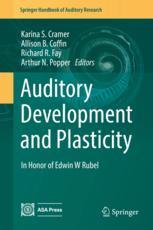

Most ebook files are in PDF format, so you can easily read them using various software such as Foxit Reader or directly on the Google Chrome browser.
Some ebook files are released by publishers in other formats such as .awz, .mobi, .epub, .fb2, etc. You may need to install specific software to read these formats on mobile/PC, such as Calibre.
Please read the tutorial at this link: https://ebookbell.com/faq
We offer FREE conversion to the popular formats you request; however, this may take some time. Therefore, right after payment, please email us, and we will try to provide the service as quickly as possible.
For some exceptional file formats or broken links (if any), please refrain from opening any disputes. Instead, email us first, and we will try to assist within a maximum of 6 hours.
EbookBell Team

4.7
106 reviewsThis volume presents a set of essays that discuss the development and plasticity of the vertebrate auditory system. The topic is one that has been considered before in the Springer Handbook of Auditory Research (volume 9 in 1998, and volume 23 in 2004) but the field has grown substantially and it is appropriate to bring previous material up to date to reflect the wealth of new data and to raise some entirely new topics. At the same time, this volume is also unique in that it is the outgrowth of a symposium honoring two-time SHAR co-editor Professor Edwin W Rubel on his retirement. The focus of this volume, though, is an integrated set of papers that reflect the immense contributions that Dr. Rubel has made to the field over his career. Thus, the volume concurrently presents a topic that is timely for SHAR, but which also honors the pioneer in the field. Each chapter explores development with consideration of plasticity and how it becomes limited over time. The editors have selected authors with professional, and often personal, connections to Dr. Rubel, though all are, in their own rights, outstanding scholars and leaders in their fields. The specific audience will be graduate students, postdoctoral fellows, and established psychologists and neuroscientists who are interested in auditory function, development, and plasticity. This volume will also be of interest to hearing scientists and to the broad neuroscience community because many of the ideas and principles associate with the auditory system are applicable to most sensory systems. The volume is organized to appeal to psychophysicists, neurophysiologists, anatomists, and systems neuroscientists who attend meetings such as those held by the Association for Research in Otolaryngology, the Acoustical Society of America, and the Society for Neuroscience.